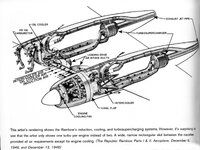I'm curious about a couple of things regarding the Republic XF-12
Firstly: I'm curious if anybody has any diagrams of the propulsion system: It was extraordinarily well-designed and seems like something that would be interesting to see from a historical and technical standpoint.
Secondly: While I have little interest in the airliner version of the aircraft, what I found interesting was that it was said to have a load-factor that was lower than the XF-12. That makes me wonder what the load-factor of the XF-12 was. While large aircraft tend not to be terribly nimble or agile, there have been some large aircraft that have been surprisingly agile (Ju 88: Ultimate load: 8.1g; He 177: Ultimate Load: 7.2g; Mosquito: Ultimate Load: 8g) and agility does help increase the survivability of a reconnaissance aircraft.
 Airframes
,
Airframes
,
 fubar57
,
fubar57
,
 Jimbob
,
Jimbob
,
 Micdrow
,
M
MIflyer
,
Micdrow
,
M
MIflyer
,
 MiTasol
,
S
Shortround6
,
MiTasol
,
S
Shortround6
,
 swampyankee
swampyankee
 tomo pauk
,
tomo pauk
,
 VERSUCH
,
W
wuzak
VERSUCH
,
W
wuzak
Firstly: I'm curious if anybody has any diagrams of the propulsion system: It was extraordinarily well-designed and seems like something that would be interesting to see from a historical and technical standpoint.
Secondly: While I have little interest in the airliner version of the aircraft, what I found interesting was that it was said to have a load-factor that was lower than the XF-12. That makes me wonder what the load-factor of the XF-12 was. While large aircraft tend not to be terribly nimble or agile, there have been some large aircraft that have been surprisingly agile (Ju 88: Ultimate load: 8.1g; He 177: Ultimate Load: 7.2g; Mosquito: Ultimate Load: 8g) and agility does help increase the survivability of a reconnaissance aircraft.

